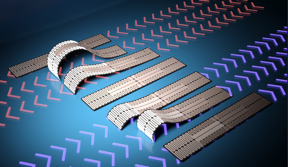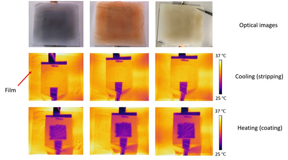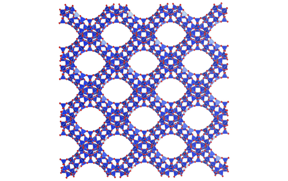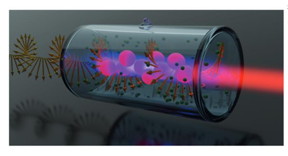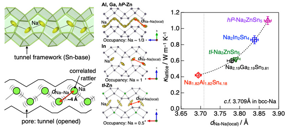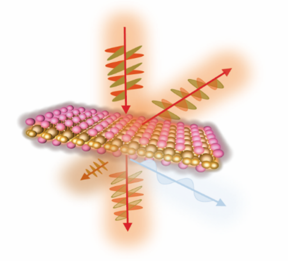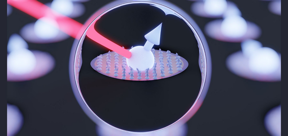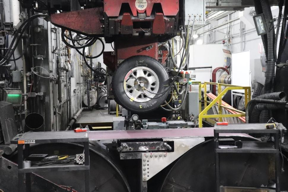Home > Press > Discovering features of band topology in amorphous thin films
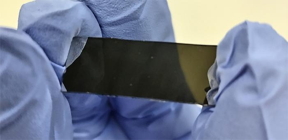 |
| The amorphous thin film experimented on in this study. CREDIT Tohoku University |
Abstract:
In recent years, scientists have been studying special materials called topological materials, with special attention paid to the shape, i.e., topology, of their electronic structures (electronic bands). Although it is not visible in real space, their unusual shape in topological materials produces various unique properties that can be suitable for making next-generation devices.
Discovering features of band topology in amorphous thin films
Sendai City, Japan | Posted on June 30th, 2023
It was thought that in order to exploit topological physical properties, crystalline materials, where atoms are highly ordered and arranged in repeating patterns, were needed. Materials in the amorphous state, i.e., where atoms are disordered and only periodically arranged over short distances, were considered unsuitable for hosting the outstanding physical properties of topological materials.
Now, a collaborative research group has verified that even amorphous materials can have these special properties. The group was led by Associate Professor Kohei Fujiwara and Professor Atsushi Tsukazaki from Tohoku University’s Institute for Materials Research (IMR); Lecturer Yasuyuki Kato and Professor Yukitoshi Motome from the University of Tokyo’s Graduate School of Engineering and Associate Professor Hitoshi Abe at the High Energy Accelerator Research Organization’s Institute for Materials Structure Science.
Details of their findings were reported in the journal Nature Communications on June 13, 2023.
“We discovered that the concept of band topology, which has been discussed mainly in crystals, is also valid and technologically useful in amorphous states,” stated Fujiwara.
To make their discovery, the team performed experiments and model calculations on iron-tin amorphous thin films. They demonstrated that despite a short-range atom arrangement, the amorphous material still showed the same special effects as in the crystalline materials, notably the anomalous Hall effect and the Nernst effect.
“Amorphous materials are easier and cheaper to make compared to crystals, so this opens up new possibilities for developing devices using these materials. This could lead to advancements in sensing technology, which is important for creating the Internet of Things (IoT) where many devices are connected and communicate with each other,” adds Fujiwara.
Looking ahead, the group is eager to unearth more amorphous materials and develop innovative devices using them.
####
For more information, please click here
Contacts:
Public Relations
Tohoku University
Copyright © Tohoku University
If you have a comment, please Contact us.
Issuers of news releases, not 7th Wave, Inc. or Nanotechnology Now, are solely responsible for the accuracy of the content.
| Related Links |
| Related News Press |
News and information
![]() Electron collider on a chip June 30th, 2023
Electron collider on a chip June 30th, 2023
![]() New single-photon Raman lidar can monitor for underwater oil leaks: System could be used aboard underwater vehicles for many applications June 30th, 2023
New single-photon Raman lidar can monitor for underwater oil leaks: System could be used aboard underwater vehicles for many applications June 30th, 2023
Possible Futures
![]() CityU awarded invention: Soft, ultrathin photonic material cools down wearable electronic devices June 30th, 2023
CityU awarded invention: Soft, ultrathin photonic material cools down wearable electronic devices June 30th, 2023
Chip Technology
![]() Electron collider on a chip June 30th, 2023
Electron collider on a chip June 30th, 2023
![]() Breaking through the limits of stretchable semiconductors with molecular brakes that harness light June 9th, 2023
Breaking through the limits of stretchable semiconductors with molecular brakes that harness light June 9th, 2023
Discoveries
![]() CityU awarded invention: Soft, ultrathin photonic material cools down wearable electronic devices June 30th, 2023
CityU awarded invention: Soft, ultrathin photonic material cools down wearable electronic devices June 30th, 2023
Materials/Metamaterials/Magnetoresistance
![]() Nanobiotechnology: How Nanomaterials Can Solve Biological and Medical Problems April 14th, 2023
Nanobiotechnology: How Nanomaterials Can Solve Biological and Medical Problems April 14th, 2023
![]() New Developments in Biosensor Technology: From Nanomaterials to Cancer Detection April 14th, 2023
New Developments in Biosensor Technology: From Nanomaterials to Cancer Detection April 14th, 2023
![]() Diamond cut precision: University of Illinois to develop diamond sensors for neutron experiment and quantum information science April 14th, 2023
Diamond cut precision: University of Illinois to develop diamond sensors for neutron experiment and quantum information science April 14th, 2023
![]() Understanding the mechanism of non-uniform formation of diamond film on tools: Paving the way to a dry process with less environmental impact March 24th, 2023
Understanding the mechanism of non-uniform formation of diamond film on tools: Paving the way to a dry process with less environmental impact March 24th, 2023
Announcements
![]() New single-photon Raman lidar can monitor for underwater oil leaks: System could be used aboard underwater vehicles for many applications June 30th, 2023
New single-photon Raman lidar can monitor for underwater oil leaks: System could be used aboard underwater vehicles for many applications June 30th, 2023
![]() CityU awarded invention: Soft, ultrathin photonic material cools down wearable electronic devices June 30th, 2023
CityU awarded invention: Soft, ultrathin photonic material cools down wearable electronic devices June 30th, 2023
Interviews/Book Reviews/Essays/Reports/Podcasts/Journals/White papers/Posters
![]() New single-photon Raman lidar can monitor for underwater oil leaks: System could be used aboard underwater vehicles for many applications June 30th, 2023
New single-photon Raman lidar can monitor for underwater oil leaks: System could be used aboard underwater vehicles for many applications June 30th, 2023
![]() CityU awarded invention: Soft, ultrathin photonic material cools down wearable electronic devices June 30th, 2023
CityU awarded invention: Soft, ultrathin photonic material cools down wearable electronic devices June 30th, 2023
- SEO Powered Content & PR Distribution. Get Amplified Today.
- PlatoData.Network Vertical Generative Ai. Empower Yourself. Access Here.
- PlatoAiStream. Web3 Intelligence. Knowledge Amplified. Access Here.
- PlatoESG. Automotive / EVs, Carbon, CleanTech, Energy, Environment, Solar, Waste Management. Access Here.
- BlockOffsets. Modernizing Environmental Offset Ownership. Access Here.
- Source: http://www.nanotech-now.com/news.cgi?story_id=57364
- :has
- :is
- :not
- :where
- $UP
- 10
- 13
- 2023
- 26
- 30th
- 7th
- 9th
- a
- AC
- accelerator
- accuracy
- Adds
- advancements
- ahead
- also
- Although
- and
- April
- ARE
- arranged
- arrangement
- AS
- Associate
- At
- atom
- Atsushi
- attention
- awarded
- BAND
- BE
- been
- breakthrough
- by
- called
- CAN
- Cancer
- Center
- CGI
- characteristic
- cheaper
- chip
- City
- click
- collaborative
- COM
- comment
- communicate
- Communications
- compared
- Compensation
- complex
- computing
- concept
- Confirm
- connected
- considered
- content
- could
- Creating
- credit
- crucial
- Cut
- data
- demonstrated
- Despite
- develop
- developed
- developing
- developments
- device
- Devices
- Diamond
- dimensions
- discovered
- discovering
- discovery
- discussed
- Dispersion
- down
- dry
- e
- each
- eager
- easier
- Edge
- effect
- effects
- Electronic
- end
- energy
- Engineering
- environmental
- Errors
- Ether (ETH)
- Even
- Examines
- experiment
- experiments
- Explain
- Exploit
- explore
- faster
- Features
- Film
- films
- findings
- For
- formation
- from
- future
- gif
- graduate
- Group
- Hall
- harness
- Have
- help
- High
- highly
- hosting
- How
- HTML
- http
- HTTPS
- i
- if
- illinois
- important
- in
- Inc.
- information
- innovative
- insight
- Institute
- interacting
- interaction
- Internet
- internet of things
- into
- Invention
- iot
- issue
- IT
- Japan
- journal
- jpg
- june
- lead
- Leaks
- lecturer
- Led
- less
- lidar
- limits
- links
- lowering
- mainly
- make
- Making
- many
- March
- material
- materials
- mechanism
- medical
- model
- molecular
- Monitor
- more
- motion
- Nanomaterials
- nanotechnology
- Natural
- Nature
- needed
- net
- New
- news
- next-generation
- notably
- novel
- now
- NSF
- of
- Oil
- on
- only
- opens
- or
- order
- organization
- Other
- outstanding
- over
- paid
- patterns
- Paving
- performed
- PHP
- physical
- plato
- Plato Data Intelligence
- PlatoData
- please
- possibilities
- Post
- posted
- potential
- Precision
- press
- Press Release
- process
- produces
- Professor
- properties
- provides
- Quantum
- quantum computing
- quantum information
- real
- receives
- recent
- release
- Releases
- Reported
- research
- research group
- researcher
- responsible
- return
- s
- same
- Save
- scalable
- School
- School of Engineering
- Science
- scientists
- Search
- Semiconductors
- sensors
- Shape
- Share
- Short
- showed
- significant
- significantly
- So
- Soft
- solely
- solid
- SOLVE
- Space
- special
- start
- State
- stated
- States
- Still
- structure
- Study
- Studying
- submit
- suitable
- synthetic
- system
- team
- Technology
- that
- The
- The Future
- their
- Them
- These
- they
- things
- this
- thought
- Through
- to
- tokyo
- tools
- toward
- transformative
- understanding
- underwater
- unique
- university
- University of Tokyo
- unusual
- us
- used
- using
- various
- Vehicles
- verified
- visible
- was
- Wave
- Way..
- we
- wearable
- were
- which
- with
- Yahoo
- years
- you
- zephyrnet











